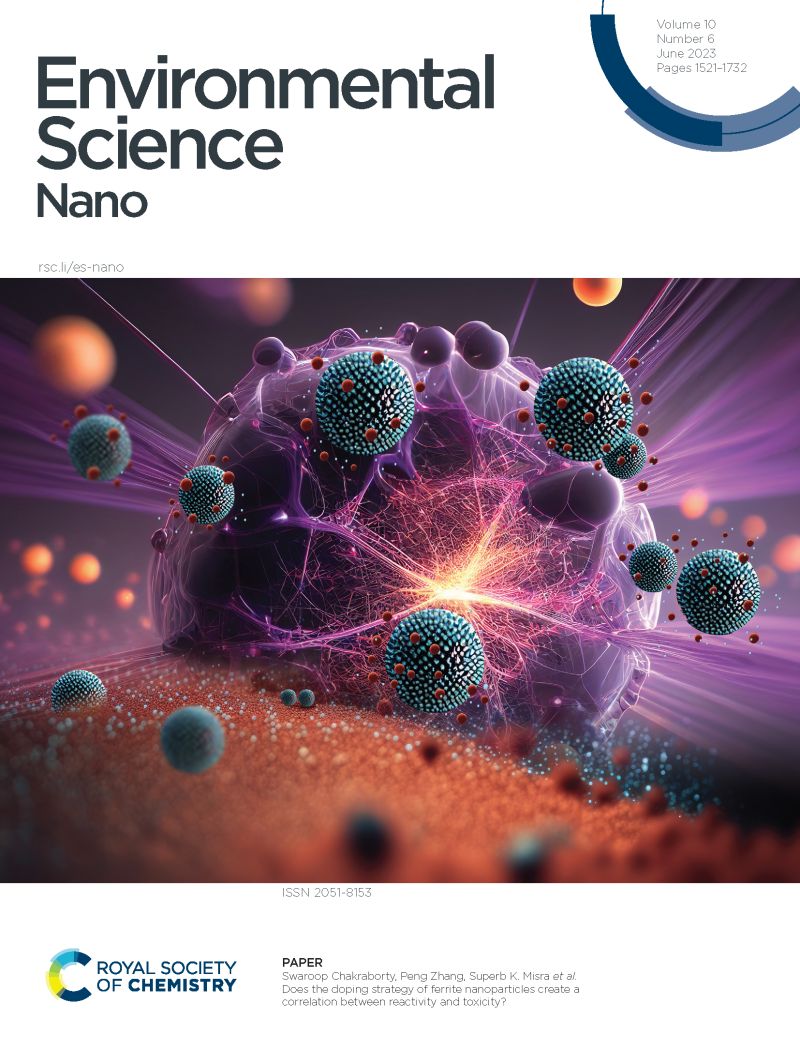Fe2O3纳米颗粒通过clec4e介导的肠道内吞作用和LDLR/ tfr1介导的黄颡鱼肝脏内吞作用被吸收
IF 5.1
2区 环境科学与生态学
Q1 CHEMISTRY, MULTIDISCIPLINARY
引用次数: 0
摘要
纳米颗粒(NPs)在肠道和肝脏中的吸收受到其生物环境的影响。然而,生物分子电晕在控制NPs摄取中的作用仍然难以捉摸。在这里,我们破译了Fe2O3 NPs在肠道表面的生物分子冕的组成。我们发现了一种膜蛋白,c型凝集素结构域家族4样(CLEC4E),是肠道Fe2O3 NPs摄取的关键贡献者。在机制上,CLEC4E介导了Fe2O3 NPs的内化,这是一个不依赖于网格蛋白和小泡的内吞途径。此外,我们表征了Fe2O3 NPs表面的血清蛋白冠的组成,并鉴定了与内噬作用相关的关键配体(载脂蛋白Eb、补体C8 α链、补体C8 β链、载脂蛋白B-100和血清转铁蛋白2异构体X4)。低密度脂蛋白受体(LDLR)和转铁蛋白受体1 (TFR1)的表达分别可以解释69%和21%的Fe2O3 NPs在6个测试组织中的生物分布。在机制上,LDLR和TFR1通过网格蛋白依赖的内吞作用介导了Fe2O3 NPs的内化。我们的研究首次表明,Fe2O3 NPs在肠道和肝脏中被不同的生物分子冠状体覆盖,并通过不同的组织特异性机制被内化。研究结果对纳米颗粒在水生生态系统中的毒理学评价和环境风险评价具有一定的指导意义。本文章由计算机程序翻译,如有差异,请以英文原文为准。
Fe2O3 nanoparticles are absorbed via the CLEC4E-mediated endocytosis in the intestine and via the LDLR/TFR1-mediated endocytosis in the liver of yellow catfish Pelteobagrus fulvidraco
The uptake of nanoparticles (NPs) in the intestine and liver is influenced by their biological milieu. However, the role of biomolecular corona in governing NPs uptake remained elusive. Here, we deciphered the composition of biomolecular corona on Fe2O3 NPs’ surface in the intestine. We identified a membrane protein, C-type lectin domain family 4E-like (CLEC4E), as a critical contributor to intestinal Fe2O3 NPs uptake. Mechanistically, CLEC4E mediated the internalization of Fe2O3 NPs in a clathrin- and caveolae-independent endocytic pathway. Additionally, we characterized the composition of serum protein corona on Fe2O3 NPs’ surface, and identified key ligands (apolipoprotein Eb, complement C8 alpha chain, complement C8 beta chain, apolipoprotein B-100, and serotransferrin-2 isoform X4) related to endocytosis. 69% and 21% of Fe2O3 NPs biodistribution among the six tested tissues could be explained by low-density lipoprotein receptor (LDLR) and transferrin receptor 1 (TFR1) expression, respectively. Mechanistically, LDLR and TFR1 mediated the internalization of Fe2O3 NPs, which was via clathrin-dependent endocytosis. For the first time, our studies show that the Fe2O3 NPs are covered by different biomolecular coronas in the intestine and liver and are accordingly internalized via distinct tissue-specific mechanisms. Our results are helpful for nanoparticle toxicological evaluation and environmental risk assessment in aquatic ecosystem.
求助全文
通过发布文献求助,成功后即可免费获取论文全文。
去求助
来源期刊

Environmental Science: Nano
CHEMISTRY, MULTIDISCIPLINARY-ENVIRONMENTAL SCIENCES
CiteScore
12.20
自引率
5.50%
发文量
290
审稿时长
2.1 months
期刊介绍:
Environmental Science: Nano serves as a comprehensive and high-impact peer-reviewed source of information on the design and demonstration of engineered nanomaterials for environment-based applications. It also covers the interactions between engineered, natural, and incidental nanomaterials with biological and environmental systems. This scope includes, but is not limited to, the following topic areas:
Novel nanomaterial-based applications for water, air, soil, food, and energy sustainability
Nanomaterial interactions with biological systems and nanotoxicology
Environmental fate, reactivity, and transformations of nanoscale materials
Nanoscale processes in the environment
Sustainable nanotechnology including rational nanomaterial design, life cycle assessment, risk/benefit analysis
 求助内容:
求助内容: 应助结果提醒方式:
应助结果提醒方式:


